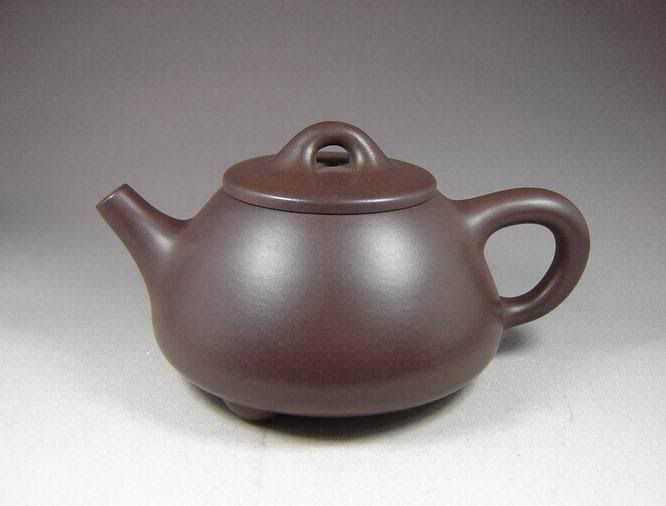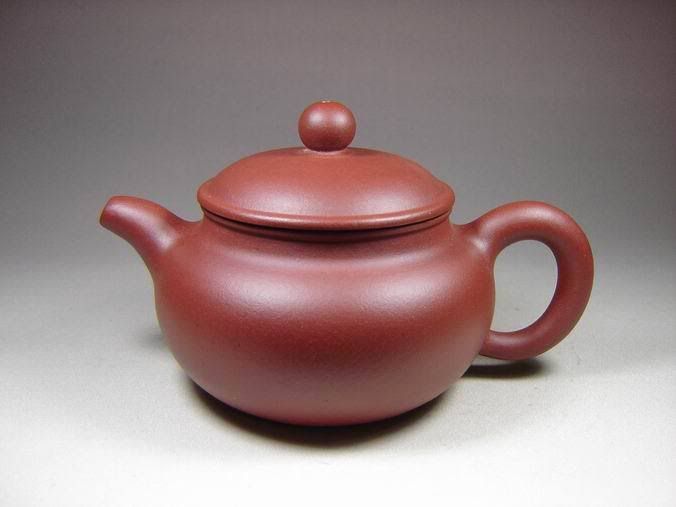Oct 22nd, '08, 10:54
Posts: 150
Joined: Mar 4th, '08, 04:04
Location: Finland
by Ritva » Oct 22nd, '08, 10:54
What kind on yixing teapot would be suitable for green oolongs? I've just started tasting oolongs so I don't know much about them or suitable teaware. So far I've been drinking japanese and chinese greens so I think I'll stick to greens in oolongs as well. Now I'm using a porcelain gaiwan for oolongs but I'd like to get a yixing - my first one! Most of the time I'm serving tea for two and I'm not into gong fu, so I've been looking for a pot that's about 200-250 ml (6.7-8.3 oz). I've read yixing discussions here on TeaChat and I've understod that Yunnan Sourcing is a reputable seller in my price range (under 50 USD). Teacuppa (where I bought my oolongs) recommends purple clay, but I read somewhere that red clay would be good for green oolongs. What do you think about these two pots (the clay and the shape) and do you have other suggestions? I also looked at the "1992 Lao Zhu Ni" pots but I don't like the grainy clay.
Yixing Purple Clay Lao Zi Ni "Shi Piao" teapot 250ml:
http://cgi.ebay.com/Lao-Zi-Ni-Shi-Piao- ... m153.l1262

Yixing Red Clay Hong Qing Ni "Fang Gu" Teapot 250ml:
http://cgi.ebay.com/Yixing-Red-Clay-Fan ... m153.l1262

About yixings in general: I've seen in some photos that pots are wet outside. I read somewhere that the pot is warmed between brews by pouring hot water over the pot. Is this common practice? Is it only for gong fu brewing or does it apply to larger pots as well?
Oct 22nd, '08, 11:23
Posts: 163
Joined: Jun 19th, '08, 19:13
by taitea » Oct 22nd, '08, 11:23
Depends on the green oolongs in question. I would divide them into rolled oolongs (tie guan yin, high mountain oolongs, etc...) which will need to expand a lot, and stringy type oolongs like baozhong. I use a pot that looks exactly like the first one you posted for baozhongs and I like it. For rolled oolongs, I think most people would say a rounder pot would be best. Something that has this sort of shape:
http://cgi.ebay.com/Da-Hong-Pao-Clay-Xi ... dZViewItem
Oct 22nd, '08, 12:11
Posts: 995
Joined: Feb 8th, '08, 14:22
Location: Fort Worth, Texas
by auggy » Oct 22nd, '08, 12:11
I know very little about yixing pots, so take this with a grain of salt, but when I was looking into getting a yixing for my oolongs (I prefer greener ones) I read somewhere that taller pots of the red clay (zhuni?) are best. Other places said that yixings can hold too much heat for greens and suggested not using yixing for them. And I think another place said just not round pots since the heat was held and circulated more in those which wasn't good for the greener ones. A few other places basically said it didn't matter (but they were trying to sell the pots so it seemed more like a "Buy this - it works for EVERYthing!" sort of thing).
After all that I read, I kind of gave up and got a round pot I like for black tea and a glass teapot for my green oolongs.
Oct 22nd, '08, 12:57
Posts: 2625
Joined: May 31st, '08, 02:44
Location: Portland, OR
by Geekgirl » Oct 22nd, '08, 12:57
I like yixing for my green oolongs, I feel like it does improve the flavor, and green oolongs don't seem to "stew" like green tea can if your using yixing. I have
this pot from YSLLC, and like it for green oolongs. (Note that the color is not the same as pictured, the pot is closer to tan.) It seems to work pretty well and is slightly larger than my other yixings, but still comparatively small, so appropriate for gongfu.
Oct 22nd, '08, 15:26
Posts: 2299
Joined: Oct 23rd, '06, 19:46
Location: Seattle Area
by tenuki » Oct 22nd, '08, 15:26
It's more of an art. If you pay attention everyone has a different story and it usually is more about selling pots than truth. My favorite pot for rolled green oolongs is a thin walled, 'fat and round', high density, ball filter, red clay. For baozhongs my favorite is a dense, thick walled, squat big bottomed one hole filter brown clay pot. However, those examples are _what I like_ to _my taste_. I select a pot for what it does to a particular tea, rules of thumb will only get you so far.
An incomplete list of characteristics and a vague, general, inaccurate idea of their supposed effect (getting the idea?).
- size - smaller is generally better, none of my pots are over 120ml, most around 90ml.
- shape - roughly match the shape of the leaves, the key is that the leaves need to have room to fully unfold. Baozhongs for instance require a fat bottom or larger pot as the leaves are quite long.
- porosity - has an effect on how much 'stuff' is absorbed, more porous pots change the flavor more. Different clays are supposed to have different porosity, but my experience is this is highly variable at the consumer lvl.
- density - is similar to porousness, but also effects temperature. can be tested by clicking the lid on the side of the pot and listening to the tone.
- thickness - effects how much heat gets retained over time.
- filter type - ball, flat, etc. match to the type of leaves, baozhong doesn't need much of a filter, but puerh usually does since the leaves are almost always broken up.
and yes, if the tea benifits from elevated temperatures during brewing you both pre-heat the pot and also pour hot water over it intermittently during brewing.
Oct 23rd, '08, 06:55
Posts: 150
Joined: Mar 4th, '08, 04:04
Location: Finland
by Ritva » Oct 23rd, '08, 06:55
Thanks for your ideas and information! Now I know better what to look for. The idea of leaf shape matching with pots (rolled oolongs for round pots and "stringy" oolongs for flat pots) sounds really logical and it's also easy to remember.

